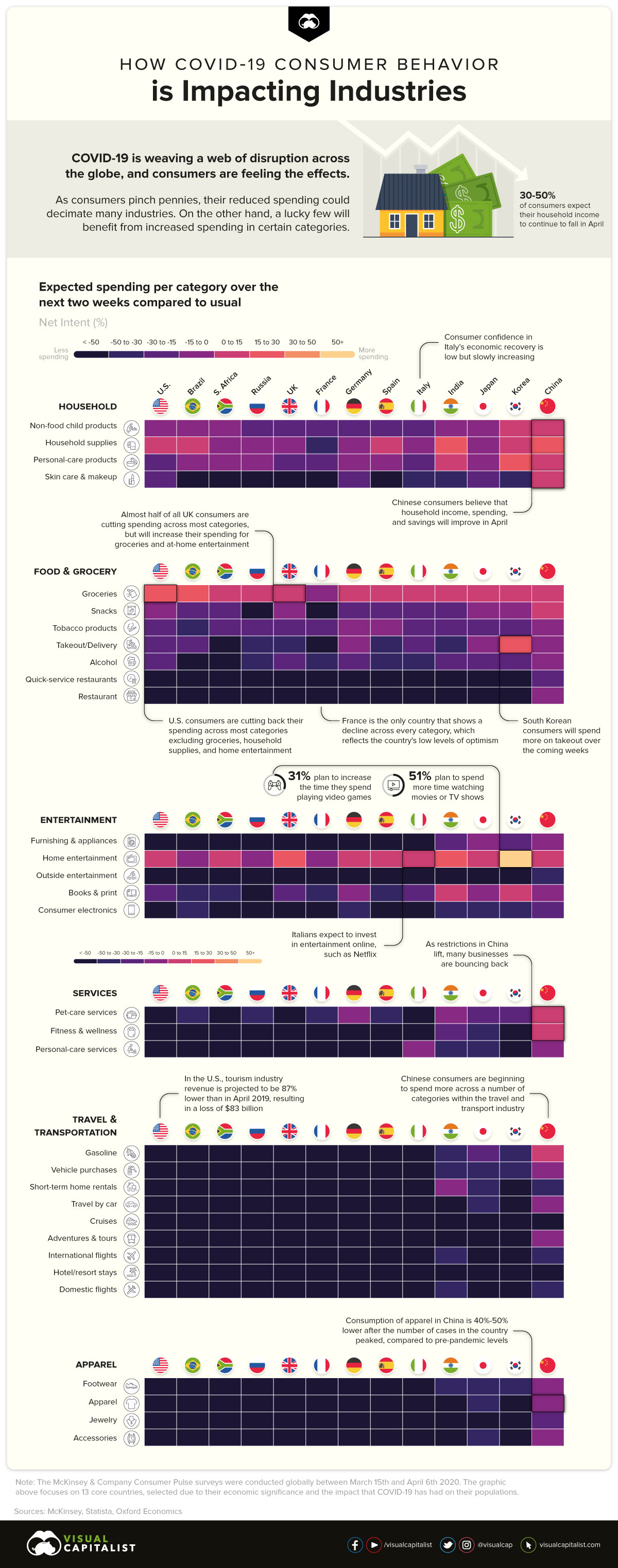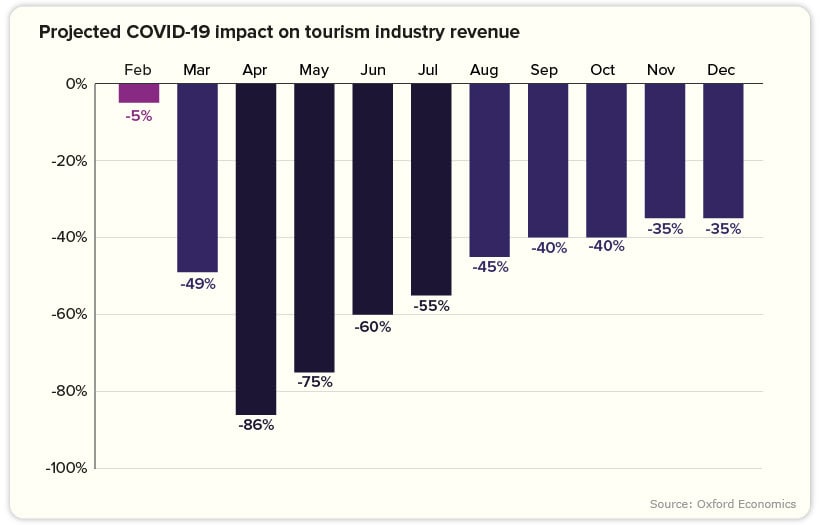These charts show how COVID-19 has changed consumer spending around the world

Few industries have been immune to the effects of the pandemic. Image: REUTERS/Leonhard Foeger
- COVID-19 has changed nearly every aspect of our daily lives, and consumer spending is no exception.
- Generally, spending is down across all industries, as lockdown measures have restricted what we can spend money on, due to restaurants and shops being shut and air travel suspended.
- Equally, the economic consequences of the coronavirus pandemic have meant consumers are less inclined to spend more, with many expecting their household income to continue to fall in the coming months.
- Time spent indoors however, has caused us to spend more on home entertainment and groceries.

How COVID-19 Consumer Spending is Impacting Industries
Consumer spending is one of the most important driving forces for global economic growth.
Beyond impacting some of the factors that determine consumer spend—such as consumer confidence, unemployment levels, or the cost of living—the COVID-19 pandemic has also drastically altered how and where consumers choose to spend their hard-earned cash.
Today’s graphic pulls data from a global survey by McKinsey & Company that analyzes how consumers are reining in their spending, causing upheaval across every industry imaginable.
While some industries are in a better position to weather the impact of this storm, others could struggle to survive.
The Link Between Sentiment and Intent to Spend
As consumers grapple with uncertainty, their buying behavior becomes more erratic. What is clear however, is that they have reduced spending on all non-essential products and services.
But as each country moves along the COVID-19 curve, we can see a glimmer of increasing optimism levels, which in turn is linked to higher spending.

India’s consumers, for example, are displaying higher levels of optimism, with more households planning to increase spend—a trend that is also evident in China, Indonesia, and Nigeria.
Meanwhile, American consumers are still more optimistic about the future than Europeans. 37% of Americans believe the country will recover in 2 or 3 months—albeit with optimism levels at the highest for people who earn over $100K.
Strategic Consumer Spending
Globally, consumers continue to spend—and in some cases, spend more compared to pre-pandemic levels—on some necessities such as groceries and household supplies.
Due to changes in media consumption habits, consumers in almost all countries surveyed say they will increase their spend on at-home entertainment. This is especially true for Korea, a country that already boasts a massive gaming culture.
As restrictions in China lift, many categories such as gasoline, wellness, and pet-care services appear to be bouncing back, which could be a positive sign for other countries following a similar trajectory. But while consumers amp up their spending on the things they need, they also anticipate spending less in other categories.
The Industries in the Red
Categories showing an alarming decline include restaurants and out-of-home entertainment.
However, there are two particularly hard-hit industries worth noting that are showing declines across every category and country:
Travel and Transport
The inevitable decline in the travel and transportation industry is a reflection of mass social isolation levels and tightening travel restrictions.
In fact, the U.S. travel industry can expect to see an average decline in revenue of 81% for April and May. Throughout 2020, losses will equate to roughly $519 billion—translating to a broader $1.2 trillion contraction in total economic impact.

According to the World Travel and Tourism Council, a staggering 50 million jobs are at risk in the industry, with 30 million of those jobs belonging to employees in Asia.
Considering the travel and tourism industry accounts for 10.4% of global GDP, a slow recovery could have serious ramifications.
Apparel
Apparel is experiencing a similarly worrying slowdown, with consumption 40-50% lower in China compared to pre-pandemic levels. Both online and offline sales for businesses the world over are also taking a major hit.
As consumers hold back on their spending, clothing brands of all shapes and sizes are forced to scale back production, and reimagine how they position themselves.
“It’s an unprecedented interruption of an industry that has relied on speeding from one season’s sales to the next. And it is bringing with it a new sense of connectedness, responsibility and empathy.”
”Towards an Uncertain Future
Clearly the force majeure that is COVID-19 has not impacted every industry equally.
For some, rebuilding their customer experience by appealing to changing values could result in a profitable, and perhaps much-needed revival. For other companies, there is no other choice but to play the waiting game.
Regardless, every industry faces one universal truth: life after the pandemic will look significantly different.
Don't miss any update on this topic
Create a free account and access your personalized content collection with our latest publications and analyses.
License and Republishing
World Economic Forum articles may be republished in accordance with the Creative Commons Attribution-NonCommercial-NoDerivatives 4.0 International Public License, and in accordance with our Terms of Use.
The views expressed in this article are those of the author alone and not the World Economic Forum.
Stay up to date:
COVID-19
The Agenda Weekly
A weekly update of the most important issues driving the global agenda
You can unsubscribe at any time using the link in our emails. For more details, review our privacy policy.
More on Health and Healthcare SystemsSee all
Shyam Bishen
November 20, 2024







